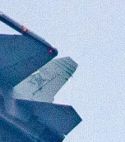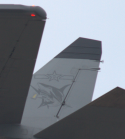You are using an out of date browser. It may not display this or other websites correctly.
You should upgrade or use an alternative browser.
You should upgrade or use an alternative browser.
J-15 carrier fighter thread
- Thread starter Jeff Head
- Start date
This might be a stupid question, but why is it that China is investing in a catapult-capable flanker? Is this not implying that J-35 is not ready or not in enough numbers to be in time for Fujian's commissioning?
The problem with your question is that it implies a belief that J-35 was ever going to be considered sufficiently ready (consider risk) and in sufficient numbers for Fujian, for the PLAN.
It also ignores that the PLAN, like the PLA as a whole, like to have viable and credible backups if their first option is delayed.
Then there's the fact that having a heavy, 4.5th gen multirole fighter is useful in general, even as a complement to a carrierborne 5th gen.
In addition to the above post, the J-15 also has capabilities that the J-35 does not. Two that come to mind are that the J-15T can carry PL-17s and YJ-12 which is a useful capability the J-35 can't replicate, and the J-15D has a whole host of EW roles that can be crucial for a carrier group. Overall, there's always a place for having a mix of warplanes and this is especially true where the J-35 is a medium fighter and the J-15 is a heavy fighter.This might be a stupid question, but why is it that China is investing in a catapult-capable flanker? Is this not implying that J-35 is not ready or not in enough numbers to be in time for Fujian's commissioning?
In addition to the above post, the J-15 also has capabilities that the J-35 does not. Two that come to mind are that the J-15T can carry PL-17s and YJ-12 which is a useful capability the J-35 can't replicate, and the J-15D has a whole host of EW roles that can be crucial for a carrier group. Overall, there's always a place for having a mix of warplanes and this is especially true where the J-35 is a medium fighter and the J-15 is a heavy fighter.
From a weight and structural pov, J-35 can probably carry PL-17 externally (no different to J-15T carrying PL-17s, if anything J-35 with PL-17 is likely to have a meaningfully smaller overall signature than J-15T with PL-17).
We have yet to receive confirmation that J-15/T can carry YJ-12.
In terms of brute capabilities, J-15T doesn't offer anything decisive which J-35 is unable to do -- but it offers a much lower risk and more ready platform than J-35 did. Considering J-15T was already in service by late last year in meaningful numbers with both STOBAR carriers, that is a meaningful uplift in capability than the standard J-15, whereas it'll likely take a couple of years for J-35 to be sufficiently ready for that sort of service scale (whether it's on the STOBAR carriers or on CV-18) simply due to being a 5th generation fighter.
Considering how sensitive the mid 2020s are, I could see why the PLAN wanted to have a potent backup to J-35 that was lower risk but more capable than J-15 and able to hit operational readiness sooner than J-35.
J-15D, of course is rather vital and unique and it would take a while for an EW variant J-35 to be developed (if ever).
This might be a stupid question, but why is it that China is investing in a catapult-capable flanker? Is this not implying that J-35 is not ready or not in enough numbers to be in time for Fujian's commissioning?
For the same reason USN operates roughly two F/A-18s for every F-35C. Nobody is trying for 100% 5th gen, it's stupid and inefficient.
This might be a stupid question, but why is it that China is investing in a catapult-capable flanker? Is this not implying that J-35 is not ready or not in enough numbers to be in time for Fujian's commissioning?
It is a "stupid" question in that no service gives up developing an existing frontline aircraft the very moment that the follow-on aircraft becomes available. The main development costs are already sunk and what you gain from further development is far more cost effective.
Just looking at the US services will tell there was the F-14D after the F-18 and there were F-18E/F, F-15EX and F-16E/F after F-22 and F-35.
Because of the sunk investment and existing assembly line and eco-system, the risk and cost of the J-15T will always be better than the J-35 until the latter production had been running for a while. That is aside from the carrying capacity and range that favor the Flanker airframe.
I suspect that, as long as the J-15T is available, mission planners aren't going to put external missiles on J-35s.From a weight and structural pov, J-35 can probably carry PL-17 externally (no different to J-15T carrying PL-17s, if anything J-35 with PL-17 is likely to have a meaningfully smaller overall signature than J-15T with PL-17).
We have yet to receive confirmation that J-15/T can carry YJ-12.
In terms of brute capabilities, J-15T doesn't offer anything decisive which J-35 is unable to do -- but it offers a much lower risk and more ready platform than J-35 did. Considering J-15T was already in service by late last year in meaningful numbers with both STOBAR carriers, that is a meaningful uplift in capability than the standard J-15, whereas it'll likely take a couple of years for J-35 to be sufficiently ready for that sort of service scale (whether it's on the STOBAR carriers or on CV-18) simply due to being a 5th generation fighter.
Considering how sensitive the mid 2020s are, I could see why the PLAN wanted to have a potent backup to J-35 that was lower risk but more capable than J-15 and able to hit operational readiness sooner than J-35.
I suspect that, as long as the J-15T is available, mission planners aren't going to put external missiles on J-35s.
I wouldn't go that far. There are absolutely mission profiles where J-35's signature reduction needs may be outweighed by the need for external carriage of weapons, even if J-15Ts are available.
My overall point is that the "J-15T able to carry external payloads" is not a very compelling reason for why they pursued J-15T on top of J-35, because if J-15T didn't exist then J-35 could absolutely carry external payloads very credibly as well, even possibly to a degree where J-35s external payload flexibility is not very different to that of J-15T.
Some thoughts on this topic.
1. The PLAN had already invested in the J-15. My guess is that it didn't require too much additional investment to develop the J-15T which, as others have said, provided a solid redundancy should the J-35 fail to deliver.
2. The J-15T may have better range/payload performance than the J-35 with external weapons loadout.
1. The PLAN had already invested in the J-15. My guess is that it didn't require too much additional investment to develop the J-15T which, as others have said, provided a solid redundancy should the J-35 fail to deliver.
2. The J-15T may have better range/payload performance than the J-35 with external weapons loadout.


